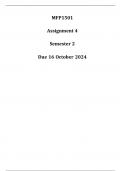MFP1501
Assignment 4
Semester 2
Due 16 October 2024
, QUESTION 1
Teaching algebra concepts in the early grades requires using patterns to make
connections.
1.1 Mention four ways you will use to teach Grade 3 learners algebra using
patterns. (4 Marks)
1. Using Color Patterns with Objects
o Introduce patterns by arranging colored objects (like blocks or beads) in
specific sequences (e.g., red-blue-red-blue). Ask students to continue the
sequence, helping them understand the concept of repetition and
predictability in patterns.
2. Number Patterns
o Show patterns using numbers, such as counting by twos or fives (e.g., 2, 4, 6,
8 or 5, 10, 15, 20). This builds a foundation for algebra by helping students
identify and extend patterns, and it introduces basic arithmetic sequences.
3. Shape Patterns
o Use shapes like triangles, squares, and circles to form sequences (e.g.,
triangle-square-circle-triangle). This allows students to identify and continue
patterns visually and connect different shapes to sequence learning.
4. Pattern Games and Activities
o Engage students with interactive activities, like clapping or stomping in a
specific rhythm pattern (e.g., clap-clap-stomp). This reinforces the concept of
patterns using auditory and kinesthetic learning styles, making it memorable
and fun for young learners.
1.2 Study the pattern below and answer the following questions:
Pattern:
1.2.1 Identify the repeating patterns
• The repeating pattern in the sequence is .




